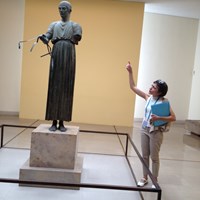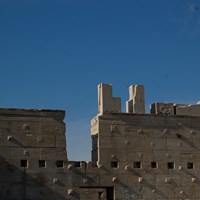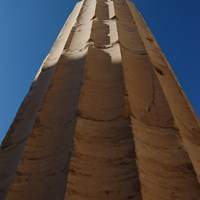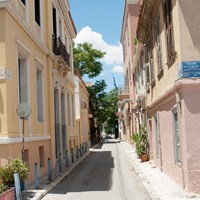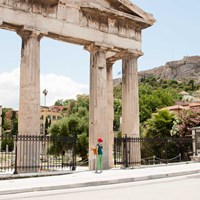TRIANTAFYLLOU GIOULI (PANAGIOTA)
TRIANTAFYLLOU GIOULI (PANAGIOTA)

Επίσημη Ταυτότητα Διπλωματούχου Ξεναγού

About me
I was born in 1977 and grew up on the island of Evia, near Athens. I studied Classics and Linguistics at the University of Athens and guiding at the Athenian School of Tourist Guides. Later, I lived for a year in Berlin and Paris studying for a postgraduate degree in Psycho- and Sociolinguistics.
I have been working as a professional tourist guide since 2003, guiding groups and individuals in various different areas of continental Greece and the Greek islands. My favorite visits in the area around Athens include Delphi, Mycenae and Epidaurus, Corinth and Eleusis, Marathon and the numerous sites and museums of Athens, such as the Acropolis and the New Acropolis Museum, the Agora and the Ceramic, the National Archeological Museum, the Museum of Cycladic Art, the Benaki Museum and the Byzantine Museum, as well as the many picturesque neighborhoods of Athens.
I'm very fond of travelling, storytelling, traditional cuisine, literature, photography, the fine arts and languages. I love guiding young children and adapting my approach to suit them. I see a guided tour not only as a means of enriching one's knowledge, but also as a potentially inspiring experience, which can give your journey that unique and special feeling!
Recommended Tours
Visiting Athens…
The fundamental visit for someone discovering Athens for the first time is the Acropolis, often combined in a half day tour with the New Acropolis Museum. However,different sites, museums and neighborhoods of the city can be combined in a guided visit, depending on the time you would like to spend and on your wishes. The following short guide of some of city's main sites and museums aims at giving you some ideas, so that we can organize together the visit that inspires you most!
The Acropolis - The Parthenon
Athens' most famous landmark.
The most famous site of Athens offers an insight to the glorious past of the city, the cradle of democracy, philosophy, Greek tragedy and many other founding principles of our civilization. On the summit of the Acropolis hill, near today's city center, still stand the temples of the 5th century BC, dedicated to the ancient gods, and landmarks of the city throughout the centuries. After walking through thePropylaea, the monumental gate of the ancient sanctuary, the visitor finds himself in front of theParthenon, the most refined of ancient Greek temples, and the gracious beauty of the smallerErechtheion, dedicated to Athena and Poseidon, and decorated with the maidens' statues known as the Caryatids.
On the south slope of the Acropolis lies the ancient theatre of Athens, in the sanctuary of the god Dionysus (Theatre of Dionysus), which can also be included in the Acropolis' visit.
The New Acropolis Museum
Where modern architecture combines with the classical aspect of the Acropolis marble sculptures.
The New Acropolis Museum, designed by Swiss architect Bernard Tschumi, opened in 2009. Exhibited on a surface of 14000 m2 are everyday life objects from antiquity, the beautiful 6th century BC marble maidens of the Acropolis sanctuary, the original statues of the Caryatids, and part of the Parthenon's unique sculptures, with an impressive panoramic view to the Acropolis.
The National Archeological Museum
The oldest museum of Athens created in the 19th century offers an impressive panorama of ancient Greek art from prehistoric times up to the Roman era. The exhibition includes real treasures, such as Cycladic idols, Agamemnon's mask and the gold of Mycenae, and the magnificent prehistoric frescoes from the volcanic island of Santorini. Also, masterpieces of ancient Greek sculpture, such as marble kouroi and reliefs, the bronze statue of Poseidon from cape Artemission, the astronomy device known as the Anticythera Mechanism, and a charming collection of ancient pottery. A fabulous museum for the lovers of ancient Greek art.
The Agora
The ancient city center.
The American School of Classical Studies revealed the ancient city center at the foot of the Acropolis and transformed the site into a beautiful garden at the heart of the modern city. A visit of the Agora offers an insight into ancient Athenian democracy, as well as trade and everyday life in antiquity. The site is also related to the philosopher Socrates, as well as the Stoics. The archeological site of the Agora includes a small but interesting museum with ancient weights and measures, objects from the ancient lawcourts and prison, ostracism ballots and ancient coins.
The Ceramic
A cemetery of the ancient city, outside the city's walls.
The walk from the Acropolis downhill and through the Agora site takes you to the Ceramic, a romantic and melancholic last stop in a complete walk through the main sites of Athens. At the Ceramic the visitor can admire the ancient city's walls, the funerary monuments of important Athenian families of the past, as well as the road leading to Plato's Academy. At the site's museum can be found unique marble sculpture works and beautiful pottery. A little river, Eridanos, since Antiquity runs through the site and adds to the charm of the visit.
Near the Ceramic lies the neighborhood of Gazi, named after the old Gas factory, now transformed into an industrial museum, famous in the last decade for its nightlife, with many restaurants, cafes and bars.
Plaka
The old city neighborhood.
Plaka, clustered around the northern and eastern slopes of the Acropolis hill, is the oldest neighborhood of Athens and a mosaic of the city's history. Walking in its labyrinthine little streets you will be charmed by the lovely 19th century neoclassical houses, the beautiful ruins or the Roman Market and the Tower of the Winds, two Ottoman period mosques and the small and harmonious Byzantine churches of the medieval period. Other highlights of the neighborhood are Lysicrates' monument known as 'Diogenes' lamp', Hadrian's Library, as well as picturesque Monastiraki square with the 19th century electrical railway station and the flea market area. An essential visit for all travelers that would like to be charmed by Athens.

Επίσημη Ταυτότητα Διπλωματούχου Ξεναγού

Κάντε ένα ταξίδι πίσω στο χρόνο























